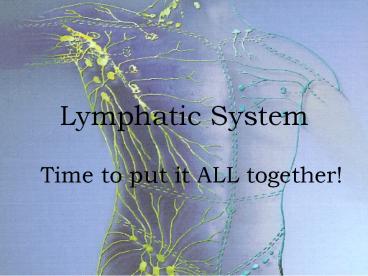Lymphatic System - PowerPoint PPT Presentation
1 / 14
Title:
Lymphatic System
Description:
Lymphatic System Time to put it ALL together! What does the lymphatic system consist of? Network of lymphatic vessels Lymphoid tissues and organs Function of the ... – PowerPoint PPT presentation
Number of Views:174
Avg rating:3.0/5.0
Title: Lymphatic System
1
Lymphatic System
- Time to put it ALL together!
2
What does the lymphatic system consist of?
- Network of lymphatic vessels
- Lymphoid tissues and organs
3
(No Transcript)
4
Function of the Lymphatic System
- A circulatory system for fluids
- Returns fluid to the blood
- Removes antigens from the body
- In a nut shell picks up extra tissue fluid
(lymph), filters it and returns it to the
bloodstream
5
- How is fluid moved?
- Contraction of skeletal and smooth muscles
against lymphatic vessels - One way system
- Obstruction of system leads to edema
(accumulation of fluid in the tissues)
6
(No Transcript)
7
Organs of the Lymphatic System
8
- Lymph nodes
- Grouped together at various parts of the body
- Filtration
- Immune surveillance
- immune cells are concentrated there
- Lymphocytes develop in lymph nodes
9
(No Transcript)
10
- What do antibodies do? (five classes)
- Ig (immunoglobulin) G- active in blood against
- bacteria and viruses helps activate complement
proteins helps phagocytes eliminate antigens
most common antibody in the blood because its
the only one that can pass the placental membrane - IgM- reacts with certain antigens, usually on
first exposure, free floating in plasma - IgA- protects mucosal surfaces from attachment of
pathogens (saliva, tears, intestinal juice and
milk) - IgE is involved in allergic reactions, sticks to
mast cells, which release inflammatory substances - IgD is usually found on B cells (not released)
may be involved in B cell activation
11
Summary The lymphatic system helps maintain
homeostasis of fluids, and also helps remove
antigen from the body The immune system
consists of barriers (physical and chemical) and
specific and nonspecific mechanisms to eliminate
antigen Immune cells are blood cells. Some
circulate in the blood and can then migrate into
tissues at site of injury. These include
neutrophils and macrophages.
12
All blood cells arise in the bone marrow. B
lymphocytes initially develop in the bone marrow
and then migrate to lymphoid tissues (esp. lymph
nodes and spleen) T lymphocytes develop in the
thymus. B cells produce antibodies, which
interact with antigen to help eliminate
it. Helper T cells regulate the immune
response cytotoxic T cells kill virus-infected
cells and probably tumor cells. (They also
are responsible for transplant rejection.)
13
B and T cell response is antigen-specific
and has memory (second response is faster and
stronger than the first) Immune system can be
overly responsive to antigens (hypersensitivity/a
llergy) or can mistakenly be directed against
self antigen (autoimmunity) Immune deficiencies
leave people vulnerable to infection
14
References
- http//www.hartnell.cc.ca.us/faculty/awright/power
point/b11lymphatic.ppt30






























